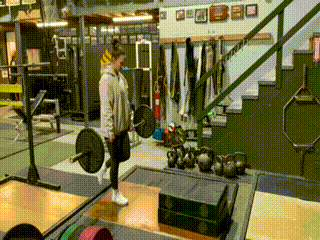How To Perform RDL
How To Perform RDLs For Stronger, More Defined Hamstrings
The posterior chain is a helluva muscle group and is given a lot of training precedent in our strength training app, Peak Strength. Including the upper body, the entirety of the musculature plays a pivotal role in all things pulling, from the traps to the lats, through the spinal erectors into the glutes, cascading down through the hamstrings into the calves. The posterior chain is quite the collection of muscles needed to coordinate as a highly functional team to drive athletic performance.
From a lower body perspective, the posterior chain is seen from the perspective of the big muscle bellies–the glutes and hamstrings (AKA hammies, AKA ham-hocks). Both muscle groups are big time contributors to impulse (force X time), strength, power, athleticism, and speed.
Where the glutes do a lot for acceleration, the hamstrings take on a lot of the strain around speed. As an athlete, speed is supreme ruling chancellor of the intergalactic muscle consortium for athleticism. That doesn’t actually exist, but you get the pictures–if you want to be fast and athletic, functional hamstrings, strong hamstrings, hamstrings with athletic muscle bellies are where it is at to make your locomotive speed, transient speed, and maximal mechanics at the upper echelon of sprinting to sore faster, quicker, and more explosive.
And when it comes to training the hamstrings in the weightroom for sports performance, it doesn’t get much better than the RDL, also known as the Romanian Deadlift.
What Is An RDL?
The Romanian Deadlift, better known as the RDL for the way it rolls off the tongue and adheres to internet typing speed is a fabulous exercise for the posterior chain, particularly the hamstrings.
The RDL is a special type of pulling movement that can be confused with the deadlift to a non-gym goer or a stiff leg deadlift, by the novice gym goer. No knock on the deadlift or stiff leg deadlift, both awesome movements for developing absolute strength, but the RDL is the superior choice for athletic development.
First off, the RDL is done with a double overhead grip. And as the weight gets up there, straps are highly recommended to help overload the weight. Straps aren’t mandatory, though they definitely help. Which also brings up the point that the RDL can work the grip as well, but that’s a side effect and peripheral bonus of doing the movement, not the main aim.
To perform the RDL, step up to the barbell and deadlift/clean pull the barbell to the hip. The RDL is a compound movement, so co-contractions and coordination amongst many muscles needs to take place.

Once the barbell is in the hip, you want to hinge at the hip and keep a slight bend in the knee. The RDL is not a stiff leg movement; it requires a bit of a bend, similar to how a good morning is performed.
Lower the bar with control by hinging at the hip. The butt pushes back as the bar lowers and the knees maintain that slight bend. Keep lowering the bar until it reaches below the knees, ideally somewhere around mid shin.
The barbell at mid shin, the eccentric portion of the RDL is complete and the barbell is hovering. Make sure to keep the bar tight to the body by packing the lats and keeping a stiff and neutral spine–did I mention the RDL works the spinal erectors, lower back, and upper back?
The concentric portion of the lift means it is time to lift the weight back up to the hip. So where at the mid shin portion, the hips are flexed, you now want to extend from the hips, squeezing the butt cheeks until the bar is back into the hip.
Rinse and repeat until the prescribed reps for the set are complete.
And that reading athletes is the basic barbell RDL, a tremendous pulling movement for the lower body that can develop the hamstrings and the entirety of the posterior chain and functions as a great accessory movement (and can even be used as an absolute strength exercise if the intensity is pushed heavy enough).
Hamstring Muscles & Posterior Chain
The hamstrings are the muscles on the back of the leg. They are big time contributors to running fast and lifting heavy. Athletes benefit from lifting heavy, but all athletes, except maybe wrestlers, value running fast, also known as sprinting.
The hamstrings can be broken down into three component parts:
- Biceps Femoris: The biceps femoris is the muscle on the outside of the back of the leg. It plays a role in flexing the knee joint, extending the thigh at the hip, and rotating your knee side to side with a bent knee.
- Semitendinosus: Is located in the middle of the biceps femoris and the semimembranosus; the semitendinosus buddies up with the semimembranosus to do a lot of the needed bodily functions.
- Semimembranosus: The semimembranosus is on the inside of the back of the leg. It plays a role in flexing the knee joint, extending the thigh at the hip, and offers medial rotation for your hip and lower leg.
With the RDL, the biceps femoris is one of the main muscles working. Strengthening the biceps femoris is great for athletes. It can help prevent the all too common hamstring injuries, like a ‘pulled hamstring’, as well as develop muscle belly size and strength for athletes to run faster.
But I’d be remiss if I didn’t talk about the rest of the posterior chain and how the RDL benefits the muscles.
Like the deadlift, the RDL impacts the upper back, the spinal erectors, and the lower back. The nice thing about the RDL is it isn’t quite as heavy as the deadlift, thus not having as much of a neurological fatiguing impact, while still having similar benefits around developing strength and athleticism.
That’s the upper body though, and the RDL is a lower body movement and the exercise isn’t only developing the ham-hocks. The RDL is also doing work on the glutes, building big beefy butt cheeks for squatting power, sprinting speed, and overall athleticism.
From the hinging at the hips, the RDL is working those glutes something fierce. Stronger glutes means bigger pulls, bigger squats, and more power from the legs as an athlete. More points for the positive going towards the RDL as an exercise all athletes need to be doing.

Lower Body Power Day
In Garage Strength Program Design, the lower body power day is the first day of training in the week. The lower body power day is a day that demands a lot of the body. The weight is heavy, the volume and intensity is substantial, and the programmed work makes for a solid global regime to up your athletic capabilities.
The lower body power day begins with a technical coordinating movement–think along the lines of the Olympic weightlifting lifts (the clean, the snatch, and the jerk) and variations of those lifts. The goal is to move heavy weight fast AF.
Since it is a lower body day, that typically means a clean or snatch movement will start off the day. It is important to remember that technical coordination exercises are great for athletes. They ask for changes of direction, coordinating many muscles, and putting together a pull and a squat as one movement. Technical coordination exercises are THE compound movements all athletes need to be doing.
Following the technical coordination exercise is the absolute strength movement. Think powerlifting (squat or pull, and their variations, on the lower body days, bench press or a variation of on the upper body days). InGSPD, the deadlift is not typically used since so much pulling occurs through performing the dynamic movements of the clean and snatch during the technical coordination exercises. However, that doesn’t mean pulls like RDLs, clean pulls, and snatch pulls are off the table.
The day then concludes with accessory movements meant to target lagging muscle groups, build lean muscle mass, and create structural stability around joints. The accessory portion of the day is a great place for the RDL to shine, especially when variations of the movement are used, which is discussed further down in the blog.
Impulse Day
Impulse day is a unique day in the GSPD system. Impulse day can be used as a full body workout day, or it can be used as a lower body specific workout day.
In the case of this blog, it is going to be looked at as a lower body specific workout.
Impulse day follows the same pattern as the lower body power day, but the focus shifts from developing strength and power to developing athletes' capability to express impulse, which is the ability to produce force in the quickest amount of time.
So programming legs on an impulse day, the aim is fast movements. Velocity and speed of execution is where it is at. This doesn’t mean reckless, out of control movement, but means speedy execution of exercises. For instance, a muscle snatch velocity is higher than a full snatch’s velocity. In that regard, the muscle snatch is applicable from a strict impulse perspective.
Now, let’s understand that there is more than one way to skin a feline, but the quicker velocity of the one movement, the muscle snatch, to the other movement, the full snatch, helps illustrate the larger point.
In this same way, doing unbroken front squats is more aligned with impulse then pause back squats. Why? Because the unbroken movement focuses on velocity and speed of execution, the front squat naturally creates a lighter intensity relative to the back squat.
The RDL functions in a similar way as the front squat. Look at the deadlift as the equivalent to the back squat in this scenario. The barbell is at a deadstop, lifted up, and the load is substantial. Where the RDL puts the musculature under constant tension, the reps are performed in succession, the intensity is naturally less, and the decreased range of motion allows for higher speeds. Perfect for impulse day.
There are also variations of the RDL that serve the purpose of developing impulse from a biomechanical perspective for athletes in an excellent way.
RDL Variations
The RDL can be varied in many, many ways. Earlier in the blog, I described the classic barbell RDL at length. Think it is important to note that the standard RDL can be performed with a clean grip or snatch grip, both serving the cause of strengthening the hamstrings and posterior chain in a wonderful manner.
But besides changing grip, I want to give y’all some wonderful variations of the RDL, particularly versions that help with athleticism.
Single Leg RDL
The single leg RDL is great because it develops unilateral strength. As all athletes know, unilateral strength is pivotal to balance, athleticism, and speed.

The single leg RDL is great and becomes even cooler when you start to see all the variations that can come from it. However, there is one unique version of the single leg RDL that takes the movement to another level.
What is that movement?
It is the chaos RDL. The chaos RDL differs from the single leg RDL in one unique way. What is it your inner monologue asks as you read? You simply put your back leg on a suspended band.
To suspend the band, simply place the band across two J-hooks attached to a squat rack. The bounciness of the band creates the feeling of chaos. The front leg’s need to balance needs to step up its gain and, in turn, creates a greater need for coordination around athleticism.
Once again, the chaos RDL can be performed with a barbell, a dumbbell in one hand or two, or a kettlebell in one hand or two. You can even switch what hand holds the single dumbbell or kettlebell to create a different angle of loading.

Reflexive strength exercises are designed with athletes in mind. They are exercises used to create neural adaptations specific to athletic needs. The goal is to make certain types of competitive movements to be executed as if a natural reflex, thus the name.

The single leg RDL dumbbell snatch to hip lock is another reflexive strength exercise. This one can also be done with a kettlebell.
Like the single leg RDL clean to box, the single leg RDL dumbbell snatch to hip lock eccentric portion is performed just like any RDL, but differs in the concentric portion. During the concentric portion, you want to accelerate the dumbbell as fast as possible to the overhead position.
The rear leg, the one not planted on the ground, is swung through into a hip lock. The hip lock is then held for a solid pause requiring a level of deceleration that all athletes need to possess.
You can advance this movement by dropping and catching the dumbbell during the eccentric portion of the lift if you are looking for even greater execution demands as an athlete.

Sample Lower Body Power Workout

Sample Lower Body Impulse Workout


The Bottom Line
Using RDLs is an obvious set of exercises every athlete should use to train the posterior chain, particularly the hamstrings, to contribute to overall athleticism. Athletes know that faster is better and that the hamstrings are big drivers of locomotive speed. The standard RDL, along with its variations, are great for neurological adaptations, providing mechanical tension to grow the hammies, and making those ham-hocks bullet proof.
Take either of the provided sample workouts and run through one of them next time you are in the gym. Or better yet, try both sample workouts over the course of a week when targeting your hamstrings.
If you are looking for a more robust, periodized program that is sport specific to your fitness needs, the premier strength development app for athletes, Peak Strength, will create a program from over 700 exercises to sculpt that athletic physique you’re looking for. Try a week of workouts for free at peakstrength.app today! to give you those RDL crafted hammies for faster sprinting times. Try a week of workouts for free at peakstrength.app today!


EARL KUNKEL
3x World Champion Co-Author of the Year
King of the PA Press
Blog Topics

Yo, It's Dane
Welcome to the Garage Strength Blog, where it is my goal to provide you with the experience and knowledge I've gained in the strength and conditioning world over many years of learning from both successes and failures. I train elite-level athletes in a multitude of sports from the high school to professional levels, already producing 5 Olympics and 30+ National Champions. If you want to be the next champion I train, check out my strength programs below!
Start Training With Me

Join for free educational videos EVERY WEEK on strength coaching and athletic performance

